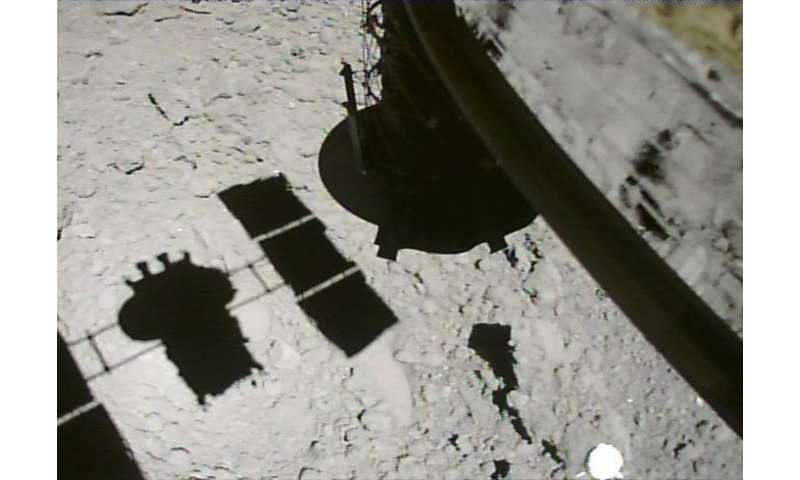by Bob Yirka , Phys.org

Credit: JAXA
A large team of researchers affiliated with multiple institutions across Japan has revealed the age of the asteroid Ryugu and other characteristics by firing a copper ball at its surface. In their paper published in the journal Science, the group describes what they have learned so far from their attempt to mimic the conditions in which craters form.
Back in 2014, Japan's JAXA space agency launched the space probe Hayabusa2—its mission was to travel to the asteroid Ryugu and learn more about it. The probe arrived at the asteroid two years ago and began its surveying mission. One of its tasks involved firing a 2-kilogram copper ball at the asteroid at 7,200 km/h. The goal was to learn more about how craters form and to learn more about the structure of Ryugu. The tennis-ball sized projectile blasted a crater onto the surface of the asteroid 14.5 meters wide and 2.3 meters deep. It also generated a brief debris cloud. In analyzing the material in the debris cloud and in the bottom and sides of the craters, the researchers have been able to learn more about the makeup of the asteroid.
The researchers found sand-like material under the rocky surface, adding credence to theories that have suggested Ryugu is a "rubble pile" type of asteroid, formed from the materials left over when a larger body is destroyed by a collision with another body. The researchers also noted that the crater was not round, but was instead more crescent-shaped, suggesting that one of its edges abuts a very large underground rock that was hard enough to avoid being fractured by the projectile.
PlayEjecta curtain growth and deposition on Ryugu. Credit: JAXA, Kobe University, Chiba Institute of Technology, Kochi University, University of Occupational and Environmental Health
The finding of sand-like material also suggests the asteroid is likely much younger than some had speculated prior to the Hayabusa2 mission. The researchers now believe it to be approximately 9 million years old. The team also noted that the formation of the crater was limited by gravity, not surface strength, again suggesting that the asteroid is made of fragile, porous material. They pointed out that the crater created by the projectile was approximately seven times bigger than it would have been on Earth, which has a much harder surface.
Explore furtherJapan spacecraft releases rover to asteroid in last mission
More information: M. Arakawa et al. An artificial impact on the asteroid 162173 Ryugu formed a crater in the gravity-dominated regime, Science (2020). DOI: 10.1126/science.aaz1701
Journal information: Science
© 2020 Science X Network
A large team of researchers affiliated with multiple institutions across Japan has revealed the age of the asteroid Ryugu and other characteristics by firing a copper ball at its surface. In their paper published in the journal Science, the group describes what they have learned so far from their attempt to mimic the conditions in which craters form.
Back in 2014, Japan's JAXA space agency launched the space probe Hayabusa2—its mission was to travel to the asteroid Ryugu and learn more about it. The probe arrived at the asteroid two years ago and began its surveying mission. One of its tasks involved firing a 2-kilogram copper ball at the asteroid at 7,200 km/h. The goal was to learn more about how craters form and to learn more about the structure of Ryugu. The tennis-ball sized projectile blasted a crater onto the surface of the asteroid 14.5 meters wide and 2.3 meters deep. It also generated a brief debris cloud. In analyzing the material in the debris cloud and in the bottom and sides of the craters, the researchers have been able to learn more about the makeup of the asteroid.
The researchers found sand-like material under the rocky surface, adding credence to theories that have suggested Ryugu is a "rubble pile" type of asteroid, formed from the materials left over when a larger body is destroyed by a collision with another body. The researchers also noted that the crater was not round, but was instead more crescent-shaped, suggesting that one of its edges abuts a very large underground rock that was hard enough to avoid being fractured by the projectile.
PlayEjecta curtain growth and deposition on Ryugu. Credit: JAXA, Kobe University, Chiba Institute of Technology, Kochi University, University of Occupational and Environmental Health
The finding of sand-like material also suggests the asteroid is likely much younger than some had speculated prior to the Hayabusa2 mission. The researchers now believe it to be approximately 9 million years old. The team also noted that the formation of the crater was limited by gravity, not surface strength, again suggesting that the asteroid is made of fragile, porous material. They pointed out that the crater created by the projectile was approximately seven times bigger than it would have been on Earth, which has a much harder surface.
Explore furtherJapan spacecraft releases rover to asteroid in last mission
More information: M. Arakawa et al. An artificial impact on the asteroid 162173 Ryugu formed a crater in the gravity-dominated regime, Science (2020). DOI: 10.1126/science.aaz1701
Journal information: Science
© 2020 Science X Network
No comments:
Post a Comment